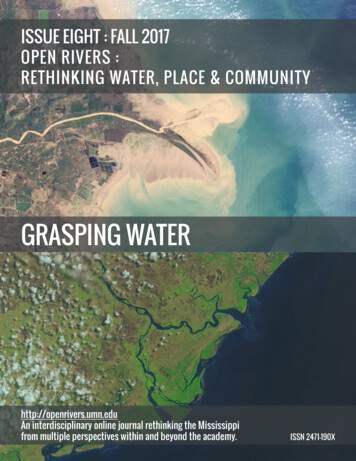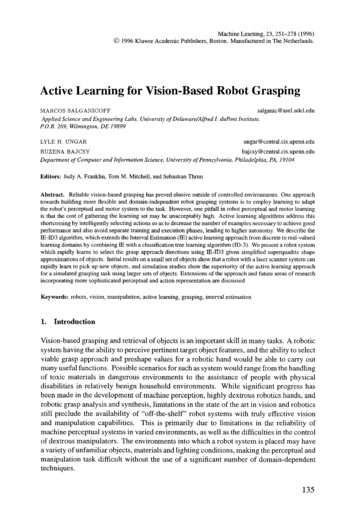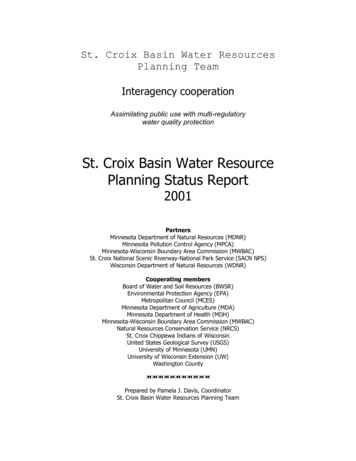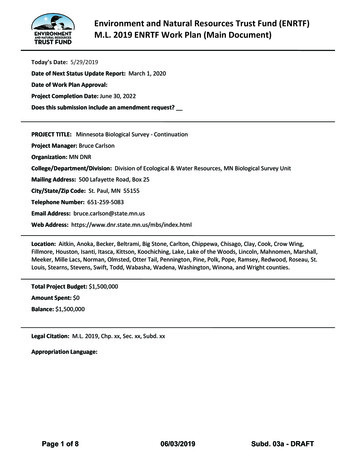
Transcription
ISSUE EIGHT : FALL 2017OPEN RIVERS :RETHINKING WATER, PLACE & COMMUNITYGRASPING WATERhttp://openrivers.umn.eduAn interdisciplinary online journal rethinking the Mississippifrom multiple perspectives within and beyond the academy.ISSN 2471- 190X
ISSUE EIGHT : FALL 2017The cover image is of Delta of the Yellow River, China (top) and Delta of the Zambezi River, Mozambique (bottom). Landsat imagery courtesy of NASA Goddard Space Flight Center and U.S. GeologicalSurvey.Except where otherwise noted, this work is licensed under a Creative Commons Attribution-NonCommercial 4.0 International License. This means each author holds the copyright to her or his work, andgrants all users the rights to: share (copy and/or redistribute the material in any medium or format)or adapt (remix, transform, and/or build upon the material) the article, as long as the original authorand source is cited, and the use is for noncommercial purposes.Open Rivers: Rethinking Rethinking Water, Place & Community is produced by the University ofMinnesota Libraries Publishing and the University of Minnesota Institute for Advanced Study.EditorsEditorial BoardEditor:Patrick Nunnally, Institute for Advanced Study,University of MinnesotaJay Bell, Soil, Water, and Climate, University ofMinnesotaAdministrative Editor:Phyllis Mauch Messenger, Institute for AdvancedStudy, University of MinnesotaAssistant Editor:Laurie Moberg, Doctoral Candidate,Anthropology, University of MinnesotaMedia and Production Manager:Joanne Richardson, Institute for Advanced Study,University of MinnesotaContact UsOpen RiversInstitute for Advanced StudyUniversity of MinnesotaNorthrop84 Church Street SEMinneapolis, MN 55455Telephone: (612) 626-5054Fax: (612) 625-8583E-mail: openrvrs@umn.eduWeb Site: http://openrivers.umn.eduISSN 2471- 190XOPEN RIVERS : ISSUE EIGHT : FALL 2017Tom Fisher, Metropolitan Design Center,University of MinnesotaLewis E. Gilbert, Institute on the Environment,University of MinnesotaMark Gorman, Policy Analyst, Washington, D.C.Jennifer Gunn, History of Medicine, University ofMinnesotaKatherine Hayes, Anthropology, University ofMinnesotaNenette Luarca-Shoaf, Art Institute of ChicagoCharlotte Melin, German, Scandinavian, andDutch, University of MinnesotaDavid Pellow, Environmental Studies, Universityof California, Santa BarbaraLaura Salveson, Mill City Museum, MinnesotaHistorical SocietyMona Smith, Dakota transmedia artist; Allies:media/art, Healing Place Collaborative2
ISSUE EIGHT : FALL 2017CONTENTSIntroductionsIntroduction to Issue EightBy Patrick Nunnally, Editor . 5Guest Editors’ Introduction to Issue EightBy Ruth Mostern and Ann Waltner . 7FeaturesWatershed Colonialism and Popular Geographies of North American RiversBy Sigma Colon . 12Industrial Ornament, Modern Symbol: New Orleans’ First Waterworks on the Mississippi RiverBy Rina Faletti, Peer Review . 29Rio Yaqui—The Hiak Vatwe: The Transformation of a Cultural LandscapeBy Anabel Galindo and James Hopkins . 52River Conservancy and the Undetermined Future of the Port of Tianjin, 1888-1937By Kan Li . 64The VanishingBy Ian Teh . 87PerspectivesWhy is water sacred to Native Americans?By Rosalyn R. LaPier . 122When a river is a person: from Ecuador to New Zealand, nature gets its day in courtBy Mihnea Tanasescu . 127Geographies“C-ing” the River: from Companionship to Control to. Catastrophe or Compromise?By Stevan Harrell . 133Hydrology and World History: Rivers and Watersheds for StudentsBy Patrick Manning . 139In ReviewListening to a River: How Sound Emerges in River HistoriesBy Christopher Caskey . 146OPEN RIVERS : ISSUE EIGHT : FALL 20173
ISSUE EIGHT : FALL 2017Primary SourcesReflections of “New” Geographies: A Brief Glimpse at Pre-Modern CartographyBy Marguerite Ragnow . 155Teaching And PracticeGrasping Water Summer Institute Reading ListBy Ruth Mostern, Ann Waltner and Kan Li . 169EditorialThe People Who Make This Journal HappenBy Open Rivers Editorial Staff . 174OPEN RIVERS : ISSUE EIGHT : FALL 20174
ISSUE EIGHT : FALL 2017PERSPECTIVESWHY IS WATER SACRED TONATIVE AMERICANS?By Rosalyn R. LaPierThe Lakota phrase “Mní wičhóni,” or “Wateris life,” has become a new national protestanthem.It was chanted by 5,000 marchers at the NativeNations March in Washington, D.C. on March10, and during hundreds of protests across theUnited States in the last year. “Mní wičhóni”Activists at the Native Nations Rise protest rally against the Dakota Access and Keystone XLpipelines in Washington, D.C. via Indianz Com, Flickr. CC BY-NC-SA 2.0OPEN RIVERS : ISSUE EIGHT : FALL 2017 / PERSPECTIVES122
ISSUE EIGHT : FALL 2017became the anthem of the almost year-longstruggle to stop the building of the Dakota AccessPipeline under the Missouri River in NorthDakota.This chant mirrors the civil rights anthems of thepast, which emerged out of the African-Americanchurch. “Mní wičhóni” in the Lakota languagealso has spiritual meaning, which is rooted ina connection to nature. As a Native Americanscholar of environment and religion, I understandwhat makes the relationship between Nativepeople and the natural world unique.For Native Americans, water does not onlysustain life – it is sacred.Water and the American WestThe Great Plains of North America, home to theLakota, the Blackfeet and other tribes, is a dry,arid place. The U.S. government spends billionsof dollars to control and retain water in this“Great American desert,” as it was described inthe early 19th century.Geologist John Wesley Powell, an early directorof the U.S. Geological Survey, pointed out inan important 1878 government study that thedefining characteristic of the Great Plains andthe West was its lack of water. He attemptedto promote land ownership that was based onwatersheds, instead of dividing land into therectangular lots still in use today.Powell also recommended that America adopt anew type of land development – one that workedwith nature, so everyone had access to water.The U.S. government, however, ignored Powell’sideas. Writing on this issue later, author WallaceStegner, who was passionate about the West,commented,“[W]hat do you do about aridity .You maydeny it for a while. Then you must either adaptto it or try to engineer it out of existence.”The Lakota, the Blackfeet and the other tribesunderstood how to live with nature. They knewit was best to live within the restrictions of thelimited water supply of the Great Plains.Water as sacred placeFor thousands of years, Native American tribesacross the Great Plains developed their ownmethods of living with the natural world and itslimited water supply. They learned both throughobservation and experiment, arguably a processquite similar to what we might call science today.They also learned from their religious ideas,passed on from generation to generation in theform of stories.OPEN RIVERS : ISSUE EIGHT : FALL 2017 / PERSPECTIVESI learned from my grandparents, both membersof the Blackfeet tribe in Montana, about the sacredness of water. They shared that the Blackfeetbelieved in three separate realms of existence –the Earth, sky and water. The Blackfeet believedthat humans, or “Niitsitapi,” and Earth beings,or “Ksahkomitapi,” lived in one realm; skybeings, or “Spomitapi,” lived in another realm;and underwater beings, or “Soyiitapi,” lived inyet another realm. The Blackfeet viewed all three123
ISSUE EIGHT : FALL 2017worlds as sacred because within them lived thedivine.The water world, in particular, was held in specialregard. The Blackfeet believed that in addition tothe divine beings, about which they learned fromtheir stories, there were divine animals, such asthe beaver. The divine beaver, who could talk tohumans, taught the Blackfeet their most important religious ceremony. The Blackfeet needed thisceremony to reaffirm their relationships with thethree separate realms of reality.The Soyiitapi, divine water beings, also instructed the Blackfeet to protect their home, the waterworld. The Blackfeet could not kill or eat anythingliving in water; they also could not disturb orpollute water.The Blackfeet viewed water as a distinct place – asacred place. It was the home of divine beingsand divine animals who taught the Blackfeetreligious rituals and moral restrictions on humanbehavior. It can, in fact, be compared to MountSinai of the Old Testament, which was viewed as“holy ground” and where God gave Moses the TenCommandments.The Blackfeet Nation is an Indian reservation located east of Glacier National Park in Montana.Several waterways drain the area with the largest being the St. Mary River, Two MedicineRiver, Milk River, Birch Creek and Cut Bank Creek. There are 175 miles (282 km) of streamsand eight major lakes on the reservation. Photographer Ken Lund, via Flickr. CC BY-SA 2.0OPEN RIVERS : ISSUE EIGHT : FALL 2017 / PERSPECTIVES124
ISSUE EIGHT : FALL 2017Water as lifeNative American tribes on the Great Plainsknew something else about the relationshipbetween themselves, the beaver and water. Theylearned through observation that beavers helpedcreate an ecological oasis within a dry and aridlandscape.Morgan believed that the Blackfeet did not harmthe beaver because beavers built dams on creeksand rivers. Such dams could produce enough ofa diversion to create a pond of fresh clean waterthat allowed an oasis of plant life to grow andwildlife to flourish.As Canadian anthropologist R. Grace Morganhypothesized in her dissertation “Beaver Ecology/Beaver Mythology,” the Blackfeet sanctified thebeaver because they understood the naturalscience and ecology of beaver behavior.Beaver ponds provided the Blackfeet with waterfor daily life. The ponds also attracted animals,which meant the Blackfeet did not have to travellong distances to hunt. The Blackfeet did not needto travel for plants used for medicine or food, aswell.Sulfur Lagoon, Aguablanca, Machalilla National Park, Ecuador. Extablished in 1979, Machalilla National Park was named an internationally important wetland under the RamsarConvention in 1990.OPEN RIVERS : ISSUE EIGHT : FALL 2017 / PERSPECTIVES125
ISSUE EIGHT : FALL 2017Beaver ponds were a win-win for all concernedin “the Great American desert” that modernecologists and conservationists are beginning tostudy only now.For the Blackfeet, Lakota and other tribes of theGreat Plains, water was “life.” They understoodwhat it meant to live in a dry arid place, whichthey expressed through their religion and withintheir ecological knowledge.Rights of Mother EarthIndigenous people from around the world sharethese beliefs about the sacredness of water.The government of New Zealand recentlyrecognized the ancestral connection of the Maoripeople to their water. On March 15, the government passed the “Te Awa Tupua WhanganuiRiver Claims Settlement Bill,” which provides“personhood” status to the Whanganui River, oneof the largest rivers on the North Island of NewZealand. This river has come to be recognized ashaving “all the rights, powers, duties, and liabilities of a legal person” – something the Maoribelieved all along.Many other countries have come to view the natural world and water from a similar perspective.In Bolivia, for example, the government passedlaws in 2010 and 2012 for the “Law of the Rightsof Mother Earth,” which were motivated by thebelief that nature has legal rights. The Ecuadorianconstitution in 2008 recognized the rights of“Nature, or Pacha Mama,” with “respect for itsexistence,” which included water.The United States does not have such laws. Thisis why the Standing Rock Lakota have beendemanding for almost a year a right to cleanwater – free from the threat of potential environmental harm and to protect its sacredness.This article was originally published on TheConversation. Read the original article.Recommended CitationLaPier, Rosalyn R. 2017. “Why is water sacred to Native Americans?” Open Rivers: RethinkingWater, Place & Community, no. 8. -is-watersacred-to-native-americans/.About the AuthorRosalyn R. LaPier is a Research Associate of Women’s Studies, Environmental Studies and NativeAmerican Religion, Harvard Divinity School, Harvard University.OPEN RIVERS : ISSUE EIGHT : FALL 2017 / PERSPECTIVES126
The cover image is of Delta of the Yellow River, China (top) and Delta of the Zambezi River, Mozam-bique (bottom). Landsat imagery courtesy of NASA Goddard Space Flight Center and U.S. Geological Survey. Except where otherwise noted, this work is licensed under a Creative Commons Attribution-NonCom-mercial 4.0 International License. This means each author holds the copyright to her or his work .











